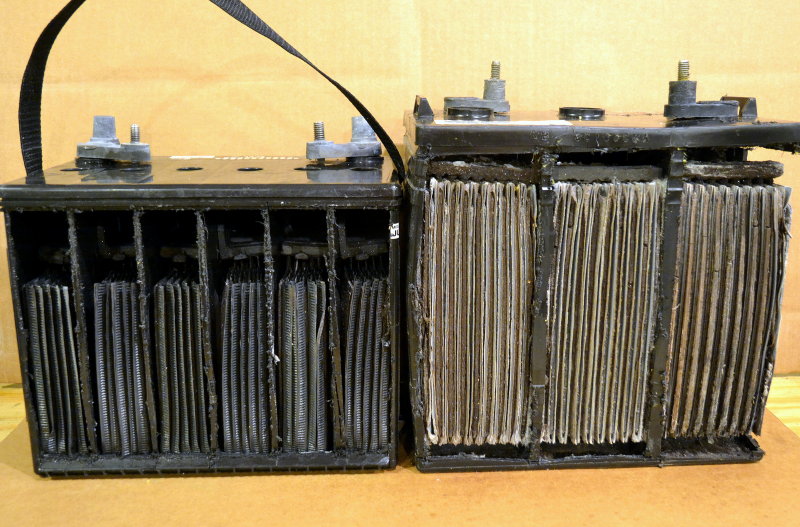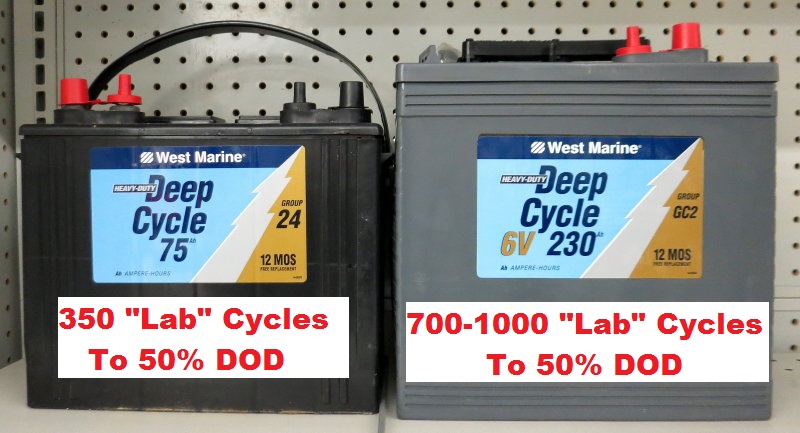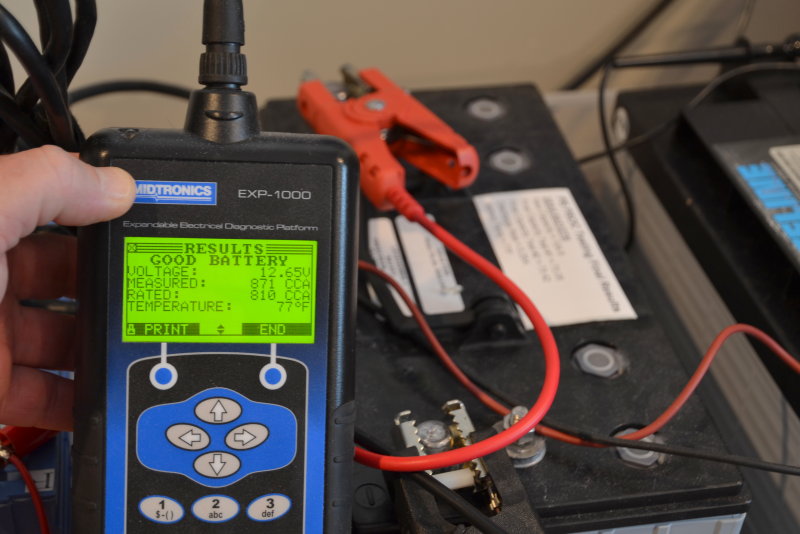A marine battery is often marketed as a deep cycle battery, but the guts of a real lead acid deep cycle battery are far different.
source:
Light Cycle vs. Deeper Cycle NOTE: This article deals with FLOODED marine batteries, not AGM or GEL batteries. The Problem: The problem, as I see it, is one of dishonest marketing where multiple battery types wear the same clothes (sticker) and will perform differently when
marinehowto.com
If your marine battery is going to be for house loads, and only emergency starting assist, then how long it can power your house loads is the more important figure than remaining CCA/MCA as displayed by a conductance tester.
The true capacity test is applying a 5 amp load for 20 hours. A new fully charged healthy 100 amp hour battery can provide 5 amps, for 20 hours, before voltage falls to 10.5v, which is considered 100% discharged.
Peukert's law means this same battery cannot provide 20 amps for 5 hours though. Thre are peukert calculators available online, but that 100Ah new healthy battery under a 20 amp load might only be able to deliver 83 amp hours.
The actual 20 hour capacity test is supposed to be done with the batteries at or very near 77f. The pros who get paid to test remaining capacity, use a water bath to keep them there.
The load is to be exact, and not change as the battery voltage falls.
Testing at the 20 hour rate, for 10 hours, can be informative, but the rate at which voltage falls in not linear. It might seem like it is just fine at 10 hours but finds it hit 10.5v at 15 hours.
As long as your starter battery is good, and you remember to switch from both to 1 or 2 on engine shutdown, then an inadequate house battery is not of much consequence.
Will your 'house' battery be able to provide enough juice for the durations of your intended loads?
DO you know the size of those loads? are they around the 20 hour rate( 5 amps for 100ah battery) higher/lower?
How long are the loads going to be experienced?
Can you easily monitor voltage while supporting those loads?
The how much battery power do I have remaining is often perplexing to those first doing so.
12.2v, rested, is generally considered 50% charged for a cycling lead acid 12v battery. a 100Ah battery under a 5 amp load in the 50% range, will read about 11.7v, and if all loads are removed, then the voltage will rebound to the 12.2 range. Perhaps in a minute, perhaps in 5 minutes.
how quickly voltage rebounds after load removal, is indicative of battery health, but also of battery temperature.
Great to have when new, and right now, data for comparison on the same specific battery, as even two off the same assembly line on same day will behave slightly differently.
If loads are well above 5 amps for that 100ah battery, then even if it were new and healthy it could not provide that 100Ah of total capacity, and if they are under that 5 amps, it can exceed that 100Ah of capacity, but not by any huge degree.
As someone who deep cycles lead acid batteries 5 times a week, knowing the amperage load is vital to knowing how the batteries are performing, but so is the columb counter/ amp hour counter, even though its Ah from full display needs to be taken with a grain of salt, and I ignore the % remaining screen as that required the true capacity of the battery be programmed.
To Newbs trying to figure out what they can power, and for how long, I usually recommend just getting a 2 decimal voltmeter, and tell them to use what they want until they are in the 12.20v range. Once there, turn off the loads and watch the voltage rebound.
If the loads were large the voltage rebound will be higher.
As it sucks not knowing the actual size of the loads, it is great to have am ammeter.
There are many inexpensive products on the market now which claim to count amp hours into/out of a battery.
I tried one ~27$ one, that uses a round hall effect sensor through which one puts one battery cable. They are OK, but clunky to program, and they need to be rezeroed when it is known no current is passing through that cable. Since I noticed this major failure I decided against trying to use it to actually count AH or WH in and out and display a percentage remaining, and just use it for amperage. Right now it is on one of my alternators, so I just rezero it before engine starting. After engine shutdown, if I leave it connected to power, it will start drifting from 0.0 amps to as high as 0.7 amps. No way it is making 0.7 amps without spinning.
If one really wants to know the remaining capacity of their battery, then the 20 hour capacity test is the benchmark.
The batteries must be in the 77f range, and the amperage load must be constant as the battery voltage falls from ~12.8 to 10.5v.
A llight bulb that draws 5 amps at 12.8v will not be drawing 5 amps at 10.7v, likely only 3.7 to 4.1 amps, and the test results will be flawed.
If I were trying to achieve truly accurate results doing 20 hour capacity tests I would get a device similar to this:
Find many great new & used options and get the best deals for 150W 200V20A Electronic USB Load Tester Constant Current Battery Capacity Tester at the best online prices at eBay! Free shipping for many products!
www.ebay.com
For those just wanting to see if their unknown health battery can provide what they need, when they need it, I would recommend just getting a 2 or preferably 3 decimal voltmeter, with ground and V sense wires right to battery terminals, amd watch voltage fall when it is powering those loads.
Find many great new & used options and get the best deals for 0.36" 5 Digit DC 0-33.000V/0-4.3000-33.000 precision Voltmeter Panel L2KD at the best online prices at eBay! Free shipping for many products!
www.ebay.com
I've got one of these, on each of my external adjustable voltage regulators field wires, temporarily. Though mine are able to be calibrated, whereas I see no mini adjustment pot in the link.
Voltage retention under load is one of the ways to determine battery health, but recharging can also reveal good clues.
A happy healthy lead acid battery needs no less than 105% of the energy taken out of it, to return to true full charge, measured by a hydrometer.
A weak unhealthy battery can be in the 130% range.
I also judge health by 'quench' amperage. Not sure if there is a widespread accepted term for this, but I consider it the amperage the battery requires, from a well depleted state, to instantly be brought to absorption voltage.
My Northstar group 31 TPPL agm, when new, this quench amperage is somewhere over 134 amps. That is the limits of my two adjustable power supplies in parallel.
For comparison my group 31 USbattery flooded marine 'deep cycle' battery this quench amperage was ~65 amps when new and was about 27 amps when I removed it from service.
Obviously such huge charging rates are not to be done each and every time, but the Northstar's seems to love it.
Their voltage retention is always significantly improved on the subsequent deep discharge cycles, and they seem to have more gusto when cranking the engine too, after the high amp recharge from a well depleted state.
I've found long times at float/maintenance voltage, has their voltage retention during lower and slower loads, and engine starting loads, to be less than expected, and a deeper cycle and a high amp recharge returns their impressive performance.
I'd recommend a highly visible voltmeter, and just watch it drop as you use your house loads.
how quickly voltage falls, and how much it falls when you add each specific load, will be highly informative, especially with more and more experience.
Then when you replace the battery you get to see just how poor/good your existing battery was, when you first started cycling it.
Knowing the size of those DC loads, and how they affect that voltage, is significantly better.
The columb/amp hour counter is a wonderful tool as well, especially when first learning, but there are a bunch of considerations and asterix's as to how far one is to trust their readings. Many a boater has claimed to never discharge their batteries much at all , but they died prematurely, and find it was wired or programmed incorrectly and their assumptions that their battery monitor was accurate to 0.1%, were incorrect in the extreme.
As for the conductance tester's ability to relate the remaining capacity of a battery:
20 Hour Capacity Test Results PUBLIC APOLOGY: First let me begin this by eating some public CROW. Over the years I have recommended these testers for boat owners or techs to use, as had the ABYC and other reputable organizations. While I have always maintained a get a baseline
marinehowto.com





